Related Research Articles

The Sinhalese people, also known as the Sinhalese are an Indo-Aryan ethno-linguistic group native to the island of Sri Lanka. Historically, they were known as the Sinhala or the Lion People. They are the largest ethnic group in Sri Lanka, constituting about 75% of the Sri Lankan population and number more than 15.2 million.

Mahāvaṃsa is the meticulously kept historical chronicle of Sri Lanka until the period of Mahasena of Anuradhapura. It was written in the style of an epic poem written in the Pali language. It relates the history of Sri Lanka from its legendary beginnings up to the reign of Mahasena of Anuradhapura covering the period between the arrival of Prince Vijaya from India in 543 BCE to his reign and later updated by different writers. It was first composed by a Buddhist monk named Mahanama at the Mahavihara temple in Anuradhapura in the 5th or 6th-century CE.
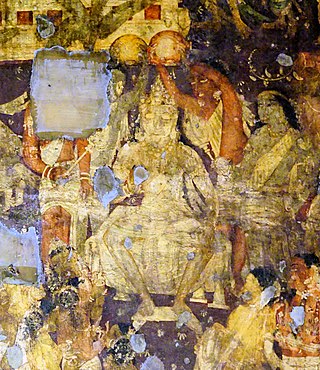
Prince Vijaya was a legendary king of Tambapanni, based in modern day Sri Lanka. His reign was first mentioned in Mahāvaṃsa. He is said to have came to Sri Lanka with a seven hundred followers after being banished from Sinhapura. However, there is no archaeological evidence of this.
Kuveni, (කුවේණි/குவேணி) also known as Sesapathi or Kuvanna or Leelawathi, was a Yakshini queen in Sri Lanka mentioned in the ancient Pali chronicles Mahavansa and Dipavansa of the Sinhalese people. The primary source for her life-story is the Mahavansa. She is venerated as Maha Loku Kiriammaleththo by the Veddas. Other names for her varying with Veddas habitats are Indigolle Kiriamma, Unapane Kiriamma, Kande Kiriamma, Divas Kiriamma, Wellasse Kiriamma, Kukulapola Kiriamma and Bili Kiriamma.

The Ruwanweli Maha Seya, also known as the Maha Thupa, is a stupa in Anuradhapura, Sri Lanka. Two quarts or one Dona of the Buddha's relics are enshrined in the stupa, making it the largest collection of his relics anywhere. It was built by Sinhalese King Dutugemunu in c. 140 B.C., who became king of Sri Lanka after a war in which the Chola King Elāra (Ellalan) was defeated. It is also known as Swarnamali Seya, Svaṇṇamāli Mahaceti and Rathnamali Seya.
Solosmasthana are 16 sacred places in Sri Lanka, believed by Buddhists to have been hallowed by visits of Gautama Buddha. These places of worship are among the most important religious locations in Sri Lanka, and are located throughout the country. Ancient Buddhist and historical sources of Sri Lanka assert that the Buddha visited the country on three occasions. These three visits are given in some detail in the ancient chronicle Mahavamsa, which describes his journeys to eleven of the Solosmasthana. Other sources such as the Pujavaliya, Samantapasadika and Butsarana also mention these visits. But there are no reliable source proves this matter. Professor senarath paranavithana in his day announced that he was not able to say that Buddha visited Sri Lanka, due to lack of archaeological evidence.
Mahiyanganaya is a town situated close to the Mahaweli River in Badulla District, Uva Province of Sri Lanka. It is said that Gautama Buddha visited Mahiyanganaya on the Duruthu full moon poya day in order to settle a dispute arose between Yakkas and Nagas and this was his first ever visit to Sri Lanka. Then the Buddha preached Dhamma to Sumana Saman, a leader in this area, to whom the Buddha gave a handful of his hair relic so that people could worship. After that Sumana Saman built a golden chethiya in which the sacred hair relic was deposited. Later on about seven chethiyas were built over the original golden chethiya from time to time, the last one being built by the King Dutugemunu. As such, this historic town is a very sacred place for Buddhists.
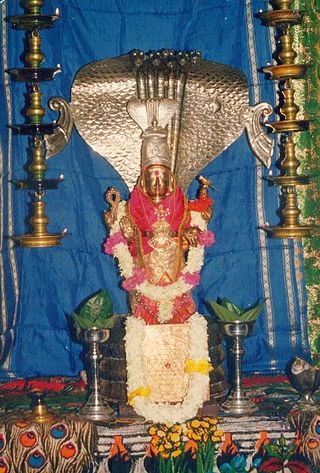
The Naga people are believed by some to be an ancient tribe who once inhabited Sri Lanka and various parts of Southern India. There are references to Nagas in several ancient texts such as Mahavamsa, Manimekalai, Mahabharata and also in other Sanskrit and Pali literature. They were generally represented as a class of super-humans taking the form of serpents who inhabit a subterranean world.
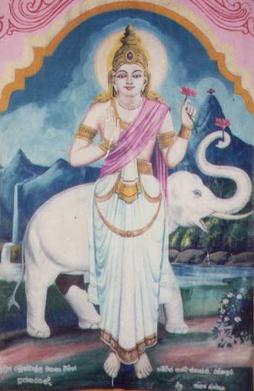
Saman is a deity, subject to local and indigenous belief and worship in Sri Lanka. The name Saman means "good minded". His character is of historical significance for the Sinhalese people and veneration especially to all the Buddhists. Maha Sumana Saman Deviraja is depicted crowned and bejeweled, holding a lotus flower in his right or left hand and accompanied by a white elephant.
Sinhalese Buddhist nationalism is a Sri Lankan political ideology which combines a focus upon Sinhalese culture and ethnicity (nationalism) with an emphasis upon Theravada Buddhism, which is the majority belief system of most of the Sinhalese in Sri Lanka. It mostly revived in reaction to the colonisation of Sri Lanka by the British Empire and became increasingly assertive in the years following the independence of the country.
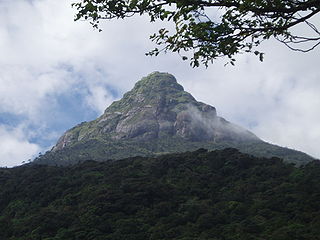
Adam's Peak is a 2,243 m (7,359 ft) tall conical sacred mountain located in central Sri Lanka. It is well known for the Sri Pada, a 1.8 m rock formation near the summit whose name is also used for the mountain itself. In Buddhist tradition the print is held to be the footprint of the Buddha, in Sri Lankan Hindu tradition that of Hanuman or Shiva, means "Mountain of Shiva's Light") and in some Islamic and Christian traditions that of Adam or St. Thomas.

The Kingdom of Tambapaṇṇī was the first Sinhalese kingdom in Sri Lanka. Its administrative centre was based at Tambapaṇṇī. It existed between 543 BC and 437 BC. According to the Mahavamsa, the Kingdom was founded by Prince Vijaya and his followers.
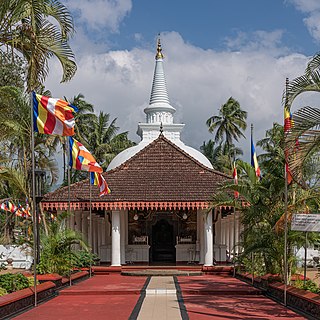
Muthiyangana Raja Maha Vihara is an ancient Buddhist temple located in the middle of Badulla town in the Badulla District of Uva Province in Sri Lanka.
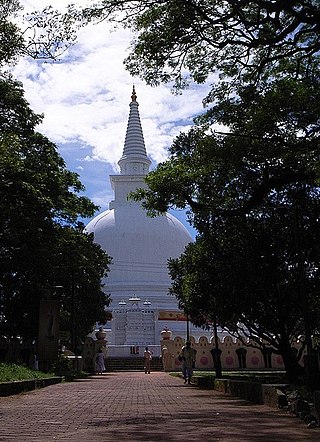
Mahiyangana Raja Maha Vihara is an ancient Buddhist temple in Mahiyangana, Sri Lanka. It is believed to be the site of Gautama Buddha's first visit to the country, and is one of the Solosmasthana, the 16 sacred religious locations in Sri Lanka. Currently this temple has been declared as one of archaeological site in Sri Lanka.
According to the Mahavamsa and Ramayana they lived among the Naga, Yakkha and Raskha. They ousted their arch enemies the Raskha from Sri Lanka, with the help of Lord Vishnu. They were then subsequently conquered by King Ravana of the Raskha. After the Yakkhas had left to live in the mountains and remote dense forests, they met Gautama Buddha who converted them to Buddhism.
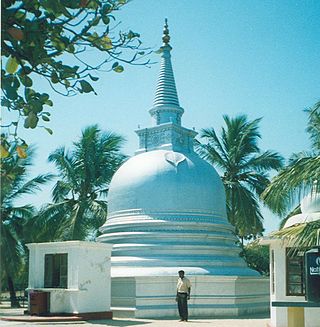
Nagadeepa Purana Vihara is an ancient Buddhist temple situated in Jaffna district of Northern Province, Sri Lanka. It is among the country's sixteen holiest Buddhist shrines (Solosmasthana). According to contemporary history, the Gautama Buddha visited the site after five years of attaining Enlightenment to settle the dispute between two warring Naga kings, Chulodara and Mahodara.

Ridi Viharaya or Silver Temple is a 2nd-century BCE Theravada Buddhist temple in the village of Ridigama, Sri Lanka. Built during the reign of Dutthagamani of Anuradhapura, the temple is considered as the place where the silver ore, which provided silver to complete Ruwanwelisaya; one of the largest stupa in Sri Lanka, was discovered. According to the chronicles Mahavamsa and Thupavamsa, the Ridi Viharaya complex was built in gratitude for helping him cherish his dream of completing Ruwanwelisaya.

According to the Mahāparinibbāṇa Sutta, after attaining parinirvana, the body of Buddha was cremated and the ashes divided among his lay followers.

The House of Vijaya was the first recorded Sinhalese royal dynasty that ruled over the island, Sri Lanka. According to Sri Lankan historical literature Prince Vijaya is the traditional first king of Sri Lanka, founding the Kingdom of Tambapanni and the dynasty subsequently founding the Kingdom of Upatissa Nuwara and finally the Anuradhapura Kingdom.

The Pre-Anuradhapura period of Sri Lankan history begins with the gradual onset of historical records in the final centuries of the prehistoric period and ending in 437 BC. According to the Mahavamsa, the original inhabitants of Sri Lanka are the Yakshas and northern Naga tribes. Sinhalese history traditionally starts in 543 BC at the arrival of Prince Vijaya, a semi-legendary king who was banished from the Indian subcontinent with his 700 followers, and is recorded in the Mahavamsa chronicle. This period was succeeded by the Anuradhapura period.
References
- 1 2 W. L. Wijayawansa . (2009). Curbing the tribesmen . Available: http://www.dailynews.lk/2009/12/31/fea25.asp Archived 29 January 2013 at the Wayback Machine . Last accessed 17 March 2010.
- ↑ John M. Senaveratna (1997). The Story of the Sinhalese. Colombo: Asian Educational Services.
- 1 2 Duruthu Poya – The Buddha’s first visit to Lanka. (2009). Gamini Jayasinghe. Available: http://www.amarasara.info/hotnews/20091231-02.htm%5B%5D. Last accessed 17 March 2010.
- ↑ Ven. S. Dhammika & BuddhaNet/Buddha Dharma Education Association Inc. (2007). Mahiyangana. Available: http://www.buddhanet.net/sacred-island/mahiyangana.html. Last accessed 17 March 2010.
- ↑ A.G.S. Kariyawasam . (1995). The Gods & Deity Worship in Sri Lanka. Available: http://www.lankalibrary.com/myths/gods.htm. Last accessed 17 March 2010.
- ↑ "Ramayana Research – Heladiva". Archived from the original on 3 May 2015. Retrieved 14 June 2015.
- H. Parker (1909). Ancient Ceylon. New Delhi: Asian Educational Services. 7.
- H.R Perera. (1988). Buddhism in Sri Lanka – A short history. Available: http://www.buddhanet.net/pdf_file/bud-srilanka.pdf. Last accessed 02 10 10.